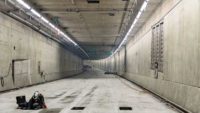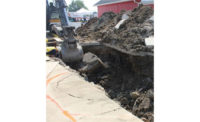In six hectic weeks, the COVID-19 pandemic has rewritten the book on construction jobsite health and risk management—elevating hygiene and disinfection to a new priority level under strict new procedures on projects still ongoing and on those set to resume after current shutdown.
Local governments that enforce building safety have added their own voices, in local safety orders, to guidelines provided by federal and state safety officials. Construction craft workers also are judging new risks involved and, either individually or, as in Massachusetts, through union representatives, deciding whether they need to choose between safety and pay.
Faced with a new layer of complexity, contractor safety managers have described strict new worker screening, cleaning, disinfection and social distance separation tactics.
In recent weeks ENR spoke with and was part of conversations among safety directors at major construction and energy firms who shared how they were navigating the new challenges. They are not identified due to the sensitive nature of the topic and the private forums in which they shared their thoughts and experiences.
Taking someone's temperature at a project gate and deciding to turn them away should be done by a third party with health experience, such as a nurse or EMT.
For one buildings-sector construction management firm that works nationally, the pandemic emergency began about six weeks ago. “People were coming to jobsites and identifying that they have the virus. We didn’t know a whole lot about it,” said a company senior safety director.
Since then, the company has sought consistency, with a long list of cleaning and decontamination responsibilities. Even with numerous projects now shut down, the safety director expects even stricter new rules will apply when work resumes.
“When we go back, the startup procedures may be more rigorous,” he says.
Challenges start outside the front gate, where access to the project must be more tightly controlled than ever.
Based on any one of four different scenarios identified by the senior safety manager in a flow chart that is tied to differing COVID-19 symptoms or exposure to someone with symptoms—a worker may be turned away and prevented from returning.
According to the flow chart, anyone who has had the virus and calls in sick needs a physician’s release to return to work. A worker who has had symptoms must stay home and call in sick until they resolve. Other possibilities involve self-quarantining and monitoring at home, depending on symptoms and possible exposures to the virus.
A third party with health experience, such as a nurse or emergency medical technician (EMT), should take a worker's temperature at the project gate and decide on admittance, says another safety director who works on many industrial projects. Larger employers are likely to use one of several third-party test services, and those companies have expanded their own staffing to fill the sudden need, another safety director said.
The screener must be seen as objective. “There is a risk in telling someone that does not work for you,” such as a subcontractor’s employee, that he or she "cannot work,” says the industrial project safety director. There can be no hint of favoritism that would exist if another staff member did the screening, he says.
For ENR’s latest coverage of the impacts of the COVID-19 pandemic, click here
Distributing masks as part of the required personal protective equipment also opens the door to more potential liability. “It could be classified as failure to protect and provide a safe workplace by providing the safety equipment but not eliminating the hazard,” says still another safety director. “Consider if someone develops a minor lung condition that may have been the result of a previous coronavirus exposure, no matter how slight,” he says. “The general contractor could be on the hook with a claim made years later.”
Some now-mandated social distancing strategies, such as limiting the number of workers on an elevator, are relatively straightforward.
But the cleaning regime on a building or industrial project can be extensive.
The checklist of one big contractor’s pandemic cleaning protocols, reviewed by ENR, now calls for blasts of bleach the entire workday.
All-Day Spraying and Wipe-Downs
Specifically, the protocols call for spraying some surfaces with a mix of 1/3 cup of household bleach in 1 gallon of water, with the mixture remaining on the material surfaces for 10 to 15 minutes before being wiped off. Other surfaces must be wiped down with a cloth dipped in the bleach and water mix.
Altogether, the contractor has a list of 46 individual locations and parts of rooms and equipment at construction jobsites and in its offices that are to be treated. The list includes hoist gates, time clocks, sign-in books, portosans and turnstyles. Interior temporary restrooms are to be sprayed four times each day. Hoist floor gates require spraying once three times per workweek. Doors and hardware, gang boxes, meeting and eating areas and congregation points are to be sprayed and wiped down daily.
Some tasks are delegated to craft workers specifically involved with a job site location or piece of equipment.
For example, plumbers are responsible for the thrice-weekly spraying of any water barrel and electricians handle spraying of generator controls weekly.
“We were doing everything we thought of on a checklist to stop the spread of the virus and keep people safe,” the big construction manager's safety director said.
But in visiting the company’s main office, he realized that the same rigor wasn’t being observed. So the firm checklist now includes office equipment and spaces.





